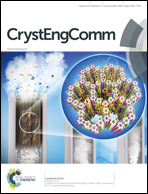Realizing high thermoelectric performance in Te nanocomposite through Sb2Te3 incorporation†
Abstract
The rational design and fabrication of nanostructures has become a fashionable strategy for pursing high thermoelectric performance in solid-state materials. Here we report nanostructured Te–Sb2Te3 composites with significantly enhanced thermoelectric performance through a scalable bottom-up method followed by a rapid sintering process. The power factor along with the carrier concentration could be significantly enhanced by increasing the number of point defects of  . Meanwhile, a great number of boundaries and hetero-interfaces between the Te and Sb2Te3 nanoparticles could play an important role in blocking phonons, resulting in the evident suppression of lattice thermal conductivity. Ultimately, a highest zT value close to 1.0 could be achieved at 623 K in samples with components of 2.6 mol% Sb2Te3 and 97.4 mol% Te. Such a peak zT value is comparable to that of doped Te materials synthesized by the conventional solid-state reaction process. This work reveals that high thermoelectric performance could be realized in an intentionally designed nanocomposite by synergistically improving the power factor and suppressing the lattice thermal conductivity.
. Meanwhile, a great number of boundaries and hetero-interfaces between the Te and Sb2Te3 nanoparticles could play an important role in blocking phonons, resulting in the evident suppression of lattice thermal conductivity. Ultimately, a highest zT value close to 1.0 could be achieved at 623 K in samples with components of 2.6 mol% Sb2Te3 and 97.4 mol% Te. Such a peak zT value is comparable to that of doped Te materials synthesized by the conventional solid-state reaction process. This work reveals that high thermoelectric performance could be realized in an intentionally designed nanocomposite by synergistically improving the power factor and suppressing the lattice thermal conductivity.



 Please wait while we load your content...
Please wait while we load your content...